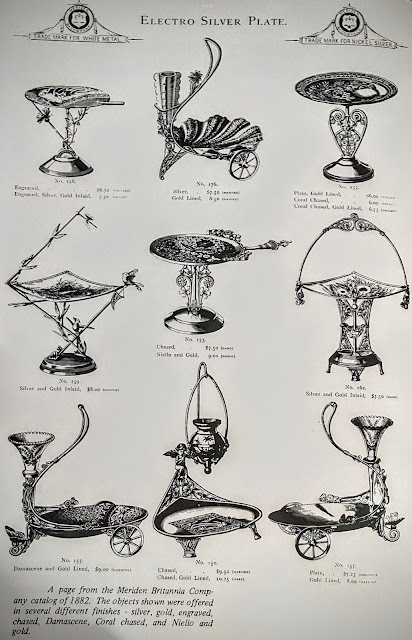In the 1860's a generally practiced social custom was "visiting" or “paying calls” on friends and acquaintances. And whether or not the “visitee” was at home, the visitor left her card in a small receptacle on the hall table, provided for the purpose.
So widespread was the custom that even in far away and sparsely settled Alaska, and as late as 1911, women observed this example of correct etiquette.
Margaret A. Murie in her book “Two in the Far North,” published by Alfred A. Knopf, Inc., describes life in Fairbanks, Alaska in 1911. (She was nine years old.):
“The respectable society of Fairbanks was very proper. Every house, no matter how small, had a ‘card tray’ on a little stand by the door, and the ladies all left cards, another fascinating little facet of life for a small girl. After the callers had left, I would study the cards ‘Mrs. Louis Kossuth Pratt’, ‘Mrs. John Knox Brown.’ To me these were somewhat awesome symbols of a world I could not know for some years.
“On Wednesday there were the meetings of the Ladies Aid or The Guild. On Thursday many ladies went out calling on the ladies who had ‘Thursdays’ engraved on the lower corners of their cards.”
At one time there was even a “language” of cards whereby the bending of the corners had special significance.
“Quite apart from such details as the correct size and typography was the difficult symbolism involved in bending the edges. Turning down the upper right-hand corner signified a personal visit; the upper left corner, congratulations; the lower right hand corner, adieu; the lower left corner, condolence; the entire left end, a call on the whole family. This practice, introduced from abroad shortly after the Civil War, commended itself to city dwellers who had little time or inclination for individual visits and yet did not wish to feel negligent of their duties... Despite its conveniences, the custom was becoming passé by the 1890s. The sign language proved too great a tax on the human intelligence.” (Reprinted with permission of The MacMillan Company from “Learning How to Behave,” by Arthur M. Schlesinger. Copyright 1946 by Arthur M. Schlesinger.)
Early card receivers were quite simple, consisting of a small tray about six inches in diameter mounted on a pedestal. And only a few styles were offered.
It was not until the 1870’s and 1880’s, when homes and home furnishings and styles in clothing reflected the Victorian trend, that card receivers came into their own. The styles then followed and perhaps even exceeded the elaborate and flamboyant taste which was the order of the day.
The old catalogs of the Meriden Britannia Co. of Meriden, Connecticut clearly demonstrate the growing popularity of card receivers, and the increasing variety of sizes, shapes and ornamentation. In 1861, four designs were offered; in 1867-71 there were fourteen; in 1879 the number had increased to thirty-one. The catalog of 1882 offered fifty-three different designs, and that of 1886, fifty-eight. This seems to have been the peak of the elaborate and unusual forms.
And what decorations there were! Card receivers were ornamented with owls, butter flies, children, cherubs, birds, fruits, cats, dogs, flowers and foliage in fantastic arrange ments. Many of them included colorful flower vases in what is known today as “art glass.”
In the early 1900’s, few styles were offered, and by then, most of them were just the card “trays” mentioned by Mrs. Murie in her book. In addition to the Meriden Britannia Co., other silverware makers in the Meriden, Connecticut area made them too. Such firms as Meriden Silver Plate Co., Middletown Plate Co., Wilcox Silver Plate Co., Wm. Rogers Mfg. Co, Derby Silver Co., and Simpson, Hall, Miller & Co., to name just a few, offered equally attractive assortments.
Despite the widespread custom of leaving cards, and the great variety of card receivers offered by so many makers over a period of forty years, this piece of Victorian silverplate seems to be scarce in antique shops today. One sees them occasionally, but they are not nearly as common as cake baskets, dinner casters, pickle casters, and butter dishes, which flourished in the same period.
—From “The Elegance of Old Silverplate and Some Personalities,” by Edmund P. Hogan
🍽Etiquette Enthusiast, Maura J. Graber, is the Site Editor for the Etiquipedia© Etiquette Encyclopedia

No comments:
Post a Comment
Note: Only a member of this blog may post a comment.